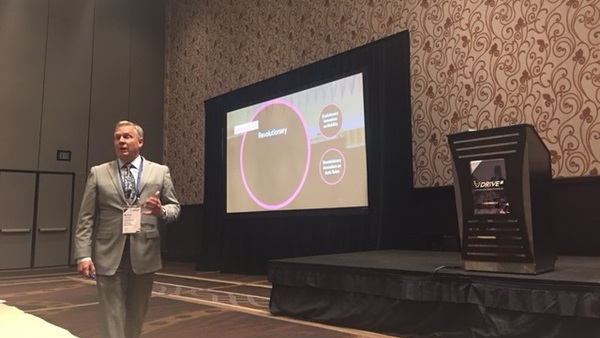
LAS VEGAS – It’s no secret that consumers are constantly shifting their behaviors and gravitating toward financial services providers that make their lives easier, more convenient and more affordable.
At CU Direct’s Drive conference Wednesday, CU Direct VP of Analytics and Advisory Services Michael Cochrum discussed four key trends in the fintech and mobility space and why credit unions should keep them on their radar.
1. Innovation. When it comes to this buzzword, credit unions should first understand that there are two types of innovation, Cochrum explained: Revolutionary, meaning the first of its kind (like the telephone) and evolutionary, meaning an improved version of an existing revolutionary product (like the smartphone).
In the auto marketplace, some companies are entering the scene as disruptors, including Tesla, which allows consumers to order a vehicle straight from the manufacturer and have it delivered to their door, and Carvana, an online-only used car dealer that stores vehicles in giant “vending machines” and restricts financing choices to a few key lenders. Cochrum noted manufacturers are beginning to apply these concepts to their business models, as well as testing alternative financing options that take lenders out of the equation.
In response to these companies’ innovative concepts, he said credit unions should be asking themselves, “Am I an innovator or an imitator?”
2. Autonomy. The idea of traveling in a car without a steering wheel might sound scary to many consumers, but Cochrum said the concept will continue to gain acceptance. Tesla was first to the autonomous driving game and others will soon follow, including Volkswagen, which plans to introduce self-driving cars in 2019, and General Motors and Lyft, which plan to partner to bring self-driving cars to the public transportation market.
He pointed out that most plane crashes occur due to pilot error, not computer error, and argued that computer-aided decisions improve outcomes. Putting it into context for credit unions, he said, “When a member gets upset, it’s often because of a mistake we made that we have to apologize to them for. We need to think of ways to use technology to improve our members’ experience and help avoid disasters.”
3. Millennials. The generation that’s always being buzzed about has very specific opinions when it comes to transportation. Cochrum said 80% weigh affordability as a reason not to buy a vehicle, 75% factor in the overall cost of ownership as a reason not to become a vehicle owner and 67% say walking and public transportation is a viable option. However, 80% are interested in buying a car, they generally enjoy driving more than other generations do, and 64% love their cars (but they’re three times more likely to ditch that car if the cost goes up). “Millennials are cheap,” Cochrum said. “If they’re paying for it with their own money, cost is a factor.”
Aside from helping keep the cost of car ownership down for millennials, credit unions should take note of two other key millennial traits – they’re engaged in and eager to adapt new technology, and value authenticity. Cochrum suggested credit unions communicate with millennials where they like to communicate and emphasize the exclusivity of credit union membership.
“The way we change people’s opinions and knowledge of credit unions is, we make it cool,” he said. One way credit unions can attract millennials is by showing them videos of members sharing their stories of how the credit union helped them save money, he added.
4. Big data. What is big data anyway? It’s in fact all the data that’s floating out there in the world, Cochrum said. Big data has experienced 1,700% growth since 2015, will be stored on more than 20 billion devices by 2020, and is relevant to credit unions because it contains nuggets of information that can help them understand what their members might do next. As an example, credit unions can use big data to discover a member recently had repairs done on their vehicle, meaning they may soon be in the market for a new one.
Cochrum said credit unions should do three things to leverage big data: Hire a data scientist, invest in custom modeling and optimize their technology.


